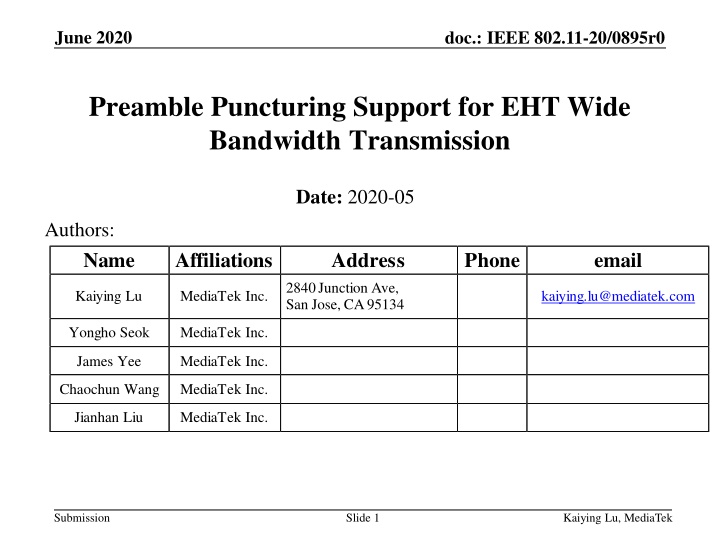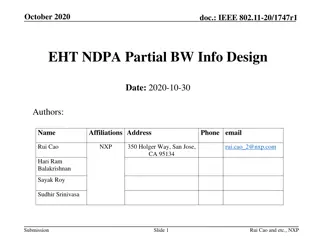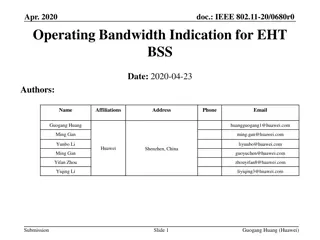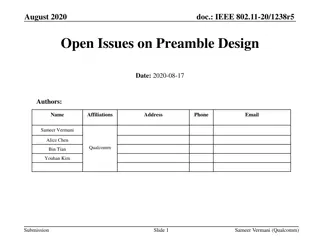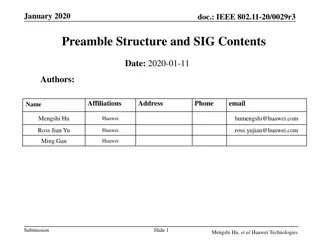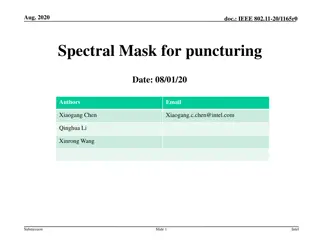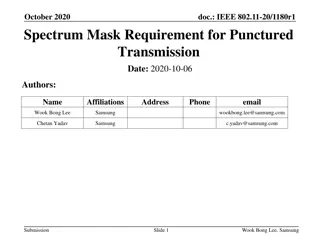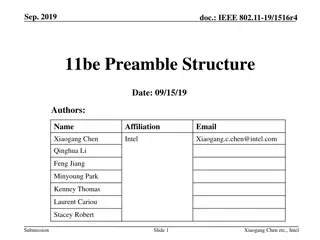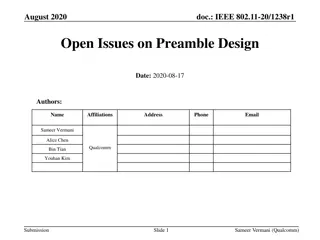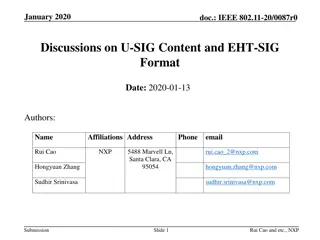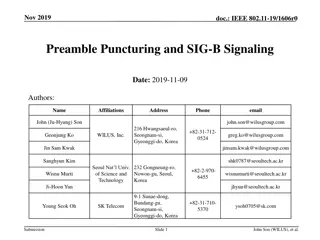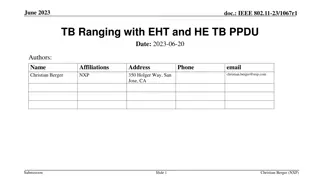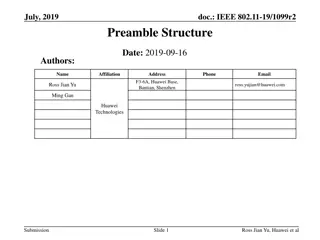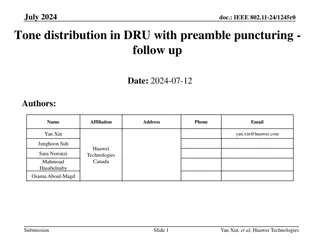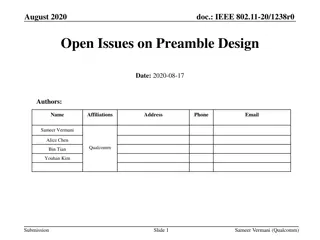Efficient Preamble Puncturing Support for IEEE 802.11 EHT Wide Bandwidth Transmission
The IEEE 802.11-20/0895r0 document addresses the introduction, issues, motivation, and support for preamble puncturing in EHT transmissions. It focuses on optimizing resource allocation while facilitating flexible preamble puncturing for OFDMA transmission in wide bandwidth scenarios, such as managing candidate PD channels, channel bitmap indication, and power-efficient monitoring strategies for non-AP STAs. The proposal aims to enhance effective channel utilization and power consumption management in a high-throughput wireless network environment.
Download Presentation

Please find below an Image/Link to download the presentation.
The content on the website is provided AS IS for your information and personal use only. It may not be sold, licensed, or shared on other websites without obtaining consent from the author.If you encounter any issues during the download, it is possible that the publisher has removed the file from their server.
You are allowed to download the files provided on this website for personal or commercial use, subject to the condition that they are used lawfully. All files are the property of their respective owners.
The content on the website is provided AS IS for your information and personal use only. It may not be sold, licensed, or shared on other websites without obtaining consent from the author.
E N D
Presentation Transcript
June 2020 doc.: IEEE 802.11-20/0895r0 Preamble Puncturing Support for EHT Wide Bandwidth Transmission Date: 2020-05 Authors: Name Affiliations Address Phone email 2840 Junction Ave, San Jose, CA 95134 Kaiying Lu MediaTek Inc. kaiying.lu@mediatek.com Yongho Seok MediaTek Inc. James Yee MediaTek Inc. Chaochun Wang MediaTek Inc. Jianhan Liu MediaTek Inc. Submission Slide 1 Kaiying Lu, MediaTek
June 2020 doc.: IEEE 802.11-20/0895r0 Introduction The 802.11be amendment shall support a preamble puncture mechanism for an EHT PPDU transmitted to one or more STAs. Based on knowledge of VHT and HE, 320MHz non-AP STAs will appear much later than 320MHz AP. In order to support small bandwidth devices in a wide bandwidth system, some devices may need to park on non-primary channels to have frame exchanges It was agreed to allow the punctured channel information carried in U-SIG to vary across different 80MHz channels, i.e. puncturing information in an 80MHz is specific to only that 80MHz. [1] Submission Slide 2 Kaiying Lu, MediaTek
June 2020 doc.: IEEE 802.11-20/0895r0 Issues When preamble is allowed to be punctured on any non- primary channels, eg. preamble puncturing is allowed in any one or two 20MHz channels of a non-primary 80MHz segment A non-AP STA parking on this segment should be capable of monitoring multiple 20MHz channels for preamble detection, which is much power consuming In order to save power, saying a non-AP STA only monitor one 20MHz channel for preamble detection, the allocated resources might be wasted if the 20MHz channel that the non-AP STA monitoring is punctured Submission Slide 3 Kaiying Lu, MediaTek
June 2020 doc.: IEEE 802.11-20/0895r0 Motivation This contribution discusses how to efficiently utilize the allocated resources among multiple users while supporting flexible preamble puncturing for OFDMA transmission. Submission Slide 4 Kaiying Lu, MediaTek
June 2020 doc.: IEEE 802.11-20/0895r0 Preamble Puncturing Support in EHT BSS An AP can indicate the channels within its operating bandwidth as disallowed or allowed channels, in which the allowed channels are the candidate preamble detection (PD) channels Eg. Disallowed channels are channels that are locally unauthorized for unlicensed use by the AFC at 6 GHz The position of each candidate PD channel in an 80MHz segment can be indicated eg. using candidate PD channel bitmap Each 1 in the bitmap represents one PD channel/allowed channel. Each 0 in the bitmap can represent the disallowed channel Submission Slide 5 Kaiying Lu, MediaTek
June 2020 doc.: IEEE 802.11-20/0895r0 Preamble Puncturing Support in EHT BSS The following figure shows the examples of candidate PD channels for a non-primary 80MHz segment Bitmap pattern 1111 : all four 20MHz channels in the 80MHz segment can be used for preamble detection Bitmap pattern 1100 : the 20MHz channels corresponding to 1 in the 80MHz segment can be used for preamble detection Four 20MHz channels are PD channels in the non-primary 80MHz segment Non-Primary 80MHz Segment Non-Primary 80MHz Segment PD Channels in the non-primary 80MHz segment Primary 80MHz Segment Primary 80MHz Segment Pattern 1111 Pattern 1100 Submission Slide 6 Kaiying Lu, MediaTek
June 2020 doc.: IEEE 802.11-20/0895r0 Preamble Puncturing Support in EHT BSS The candidate PD channels are used to select or to allocate a PD channel for preamble detection for EHT STAs parking in a specific non-primary 80MHz segment The PD channels for multiple non-AP STAs parking in the same non- primary 80MHz segment could spread over the candidate PD channels in the non-primary 80MHz segment STA1 s PD channel STA2 s PD channel Non-Primary 80MHz Segment Non-Primary 80MHz Segment STA3 s PD channel STA1 and STA3 s PD channel STA4 s PD channel STA2 and STA4 s PD channel Primary 80MHz Segment Primary 80MHz Segment Primary 20MHz Primary 20MHz Pattern 1111 Pattern 1100 Submission Slide 7 Kaiying Lu, MediaTek
June 2020 doc.: IEEE 802.11-20/0895r0 Preamble Puncturing Support in EHT BSS The AP shall follow the rules below when transmitting to STAs parking in non-primary 80MHz segment: It shall not transmit on a non-primary 80MHz segment, if all candidate PD channels for the non-primary segment are CCA busy. It may transmit on a non-primary 80MHz segment if at least one candidate PD channel for the non-primary 80MHz segment is CCA idle. It shall not transmit downlink frame or triggers uplink transmission for a non-AP STA whose allocated/selected PD channel is punctured It may transmit downlink frame or triggers uplink transmission for a non-AP STA whose PD channel is not punctured Punctured TXOP punctured 20MHz STA1 s PD channel STA2 s PD channel Non-Primary 80MHz Segment STA3 s PD channel RU allocations for STAs except for STA3 STA4 s PD channel Primary 80MHz Segment Primary 20MHz 160MHz BSS Submission Slide 8 Kaiying Lu, MediaTek
June 2020 doc.: IEEE 802.11-20/0895r0 CCA Reset on PD channel Since a non-AP STA parking on a non-primary 80MHz segment will not contend the medium, when it detected preambles on its PD channel and the detected preamble is an OBSS PPDU, the STA s MAC sublayer may issue a PHY-CCARESET.request primitive If the OBSS PPDU with RSSI less than ED threshold If a PHY-RXEND.indication(CarrierLost) primitive is generated If a PHY-RXEND.indication(FormatViolation) primitive is generated After the MAC issuing the PHY-CCARESET.request primitive to reset the PHY entity to the state appropriate for the end of a received frame and to initiate a new CCA evaluation cycle. Then STA is able to detect new preamble on its PD channel to receive the PPDU sent by its associated AP Submission Slide 9 Kaiying Lu, MediaTek
June 2020 doc.: IEEE 802.11-20/0895r0 Conclusion We believe dynamic puncturing for OFDMA transmission is useful to support non-AP STAs parking in the non-primary 80MHz segment Preamble detection channel selection or allocation scheme for non-AP STAs parking in the non-primary 80MHz segment is discussed. Submission Slide 10 Kaiying Lu, MediaTek
June 2020 doc.: IEEE 802.11-20/0895r0 SP1 Do you support that more than one candidate PD channels in each 80MHz segment should be allowed for OFDMA transmission ? Submission Slide 11 Kaiying Lu, MediaTek
June 2020 doc.: IEEE 802.11-20/0895r0 SP2 Do you support that a non-AP EHT STA parking in a non-primary 80MHz segment can be assigned or select a PD channel from the candidate PD channels? Submission Slide 12 Kaiying Lu, MediaTek
June 2020 doc.: IEEE 802.11-20/0895r0 SP3 Do you support that when a non-AP EHT STA parking in a non-primary 80MHz segment detected a preamble and determined an OBSS PPDU with RSSI less than ED threshold, its MAC entity may issue a PHY- CCARESET.request primitive to reset the PHY entity to the state appropriate for the end of a received frame and to initiate a new CCA evaluation cycle? Submission Slide 13 Kaiying Lu, MediaTek
June 2020 doc.: IEEE 802.11-20/0895r0 Reference [1] 11-20-0566-34-00be-compendium-of-straw-polls- and-potential-changes-to-the-specification- framework-document Submission Slide 14 Kaiying Lu, MediaTek
